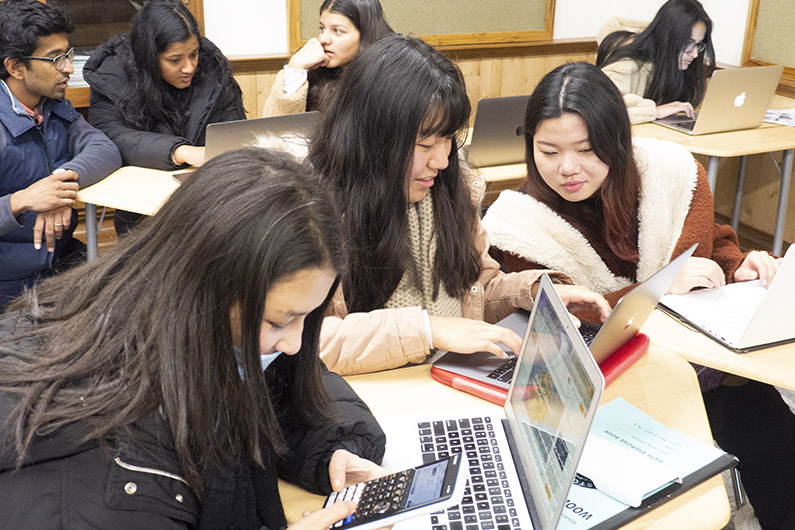
20 Apr Blending synchronous and asynchronous learning
We’re about to enter our fifth week of distance learning, the half-way point to the end of this academic year. When last year I laid out the three threads I see as essential for Woodstock’s future, one of them was further integrating the digital realm into students’ educational journeys. You could say ‘be careful what you wish for’, but Woodstock has been thrust into distance learning in a way that no one could have envisaged before the outbreak of the pandemic.
It’s been a learning curve for all of us, teachers, students and parents alike, and I want to thank those of you who could join me for the virtual question and answer session earlier in April. I welcomed the opportunity to hear what’s been working well for you and your children, as well as some of the challenges you have been facing. One question a number of parents posed was why the digital learning experience can’t more closely mirror the usual Woodstock timetable, with students having five to six synchronous lessons each day.
"The educational experience has evolved over hundreds of years to be classroom-centric, but that doesn’t necessarily mean classrooms are in themselves the optimum learning environment. What they are is a highly effective compromise between imparting knowledge, eliciting skills, and maintaining the attention of groups of students."
One clear challenge with that is our students, and to some degree our teachers, are now spread out across the world, from New Zealand to the USA, and the UK to South Korea. Running the usual timetable would effectively either exclude many of them from learning at Woodstock, or force them into working very unsustainable hours in their respective time zones. But while this is an important consideration when developing our approach to distance learning, there is a far more important one – that overuse of synchronous learning has been shown to be a very inefficient way of delivering education in an online environment.
What doesn’t work is trying to recreate the classroom over the internet. In her article in Edutopia, Why Learning at Home Should Be More Self-Directed—and Less Structured, Simone Kern argues that some parents are struggling to implement schedules that replicate school timetables because “the tightly structured, time-in-seat approach of traditional schools often has more to do with crowd control than optimizing learning”.
The educational experience has evolved over hundreds of years to be classroom-centric, but that doesn’t necessarily mean classrooms are in themselves the optimum learning environment. What they are is a highly effective compromise between imparting knowledge, eliciting skills, and maintaining the attention of groups of students. Arguably, however, the classroom is not the best environment to do any of these individually. Hence at Woodstock, so much of our educational experience takes place outside the classroom, whether that is through outdoor learning, passage activities, our music programme or at the Centre for Imagination. Spending time in the wilds during activity week can be a powerful lesson in self-determination; performing in a school play can awaken self-confidence and public speaking skills; and being part of a community engagement programme can open students’ eyes to inequality, compassion and humility. I appreciate the irony that these are many of the things that students are missing about Woodstock while confined at home; but the skills and attitude they have developed beyond the classroom should be helping them during this period of lockdown.
"As students adapt they will be learning valuable skills in balancing freedom, choice and responsibility which will stand them in good stead for the future."
Much of what happens in the classroom is an inefficient use of time in a distance learning environment. Too much time over video conferencing can take its toll on any of us, and so moving elements such as planning and setting tasks and deadlines can be moved to the asynchronous to make the best use of teachers and students’ time together. When students have to review and comprehend content such as a video or written case study, it can make sense for them to do this during the lesson in a classroom environment, but is an unproductive use of time to do so during a synchronous lesson when distance learning. Being able to ingest content asynchronously means students can move at their own pace, taking as much time as they need to absorb the knowledge.
Of course, both synchronous and asynchronous learning have their benefits, and we take a blended approach which takes the best of both elements. In a study of Asynchronous and Synchronous E-Learning, Stefan Hrastinski, Professor at the Division of Digital Learning at KTH Royal Institute of Technology, Stockholm, Sweden, found that asynchronous E-learning supports better cognitive participation, increasing individuals’ reflection and ability to process information, while synchronous E-learning increased students’ motivation and convergence on meaning. FutureLearn recommends a balance of one hour of synchronous learning for every 10-20 synchronous hours. Our approach is much more blended than that as we find many students appreciate particularly the social element of the synchronous time they spent together. But we shouldn’t underestimate the benefits of students engaging in self-directed learning that asynchronous learning can deliver. Some students will find this more challenging than others, but as they adapt they will be learning valuable skills in balancing freedom, choice and responsibility which will stand them in good stead for the future. This experience will stick with them when they return to the classroom, or for our older students, when they enter into higher education, where these abilities can make all the difference to a student’s ability to thrive. In time, I hope that when students look at their educational experience during this challenging episode, they will find that they learned a lot more than they realised.
Craig Cook, Principal






No Comments